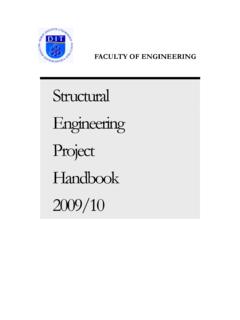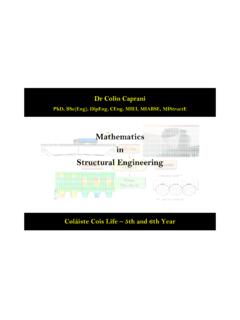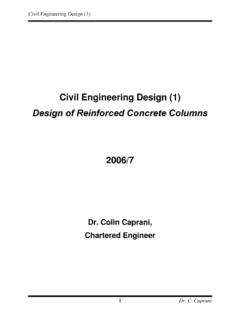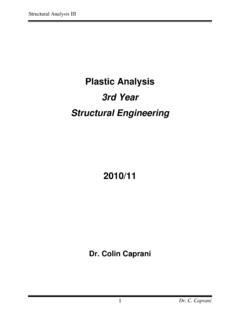Transcription of Chapter 4 - Matrix Stiffness Method - colincaprani.com
1 Structural Analysis IV Chapter 4 Matrix Stiffness Method Dr. C. Caprani 1 Chapter 4 - Matrix Stiffness Method Introduction .. 3 Background .. 3 Basic 4 Computer Programs to Support 6 Basic Approach .. 10 Individual Element .. 10 Assemblies of Elements .. 12 Example 1 .. 14 General Methodology .. 20 Member contribution to global Stiffness Matrix .. 22 Interpretation of Stiffness Matrix .. 27 Restricting a Matrix Imposing Restraints .. 29 Plane Trusses .. 32 Introduction .. 32 Truss Element Stiffness Matrix .. 35 Element Forces .. 40 Example 2: Basic Truss .. 43 Example 3: Adding Members.
2 52 Example 4: Using Symmetry .. 56 Self-Strained Structures .. 59 Example 5 Truss with Differential Temperature .. 63 Example 6 Truss with Loads & Self Strains .. 69 Structural Analysis IV Chapter 4 Matrix Stiffness Method Dr. C. Caprani 2 Problems .. 74 Beams .. 77 Beam Element Stiffness Matrix .. 77 Beam Element Loading .. 82 Example 7 Simple Two-Span Beam .. 84 Example 8 Non-Prismatic Beam .. 88 Problems .. 92 Plane Frames .. 95 Plane frame Element Stiffness Matrix .. 95 Example 9 Simple Plane frame .. 104 Example 10 Plane frame Using 109 Problems .. 115 Appendix .. 120 Plane Truss Element Stiffness Matrix in Global Coordinates.
3 120 Coordinate Transformations .. 129 Past Exam Questions .. 137 References .. 148 Rev. 1 Structural Analysis IV Chapter 4 Matrix Stiffness Method Dr. C. Caprani 3 Introduction Background The Matrix Stiffness Method is the basis of almost all commercial structural analysis programs. It is a specific case of the more general finite element Method , and was in part responsible for the development of the finite element Method . An understanding of the underlying theory, limitations and means of application of the Method is therefore essential so that the user of analysis software is not just operating a black box.
4 Such users must be able to understand any errors in the modelling of structures which usually come as obtuse warnings such as zero pivot or determinant zero: structure unstable: aborting . Understanding the basics presented herein should hopefully lead to more fruitful use of the available software. Structural Analysis IV Chapter 4 Matrix Stiffness Method Dr. C. Caprani 4 Basic Concepts Node The more general name for a connection between adjacent members is termed a node. For trusses and frames the terms joint and node are interchangeable. For more complex structures ( plates), they are not.
5 Element For trusses and frames element means the same as member. For more complex structures this is not the case. Degree of Freedom The number of possible directions that displacements or forces at a node can exist in is termed a degree of freedom (dof). Some examples are: Plane truss: has 2 degrees of freedom at each node: translation/forces in the x and y directions. Beams: have 2 degrees of freedom per node: vertical displacement/forces and rotation/moment. Plane frame : has 3 degrees of freedom at each node: the translations/forces similar to a plane truss and in addition, the rotation or moment at the joint.
6 Space Truss: a truss in three dimensions has 3 degrees of freedom: translation or forces along each axis in space. Space frame : has 6 degrees of freedom at each node: translation/forces along each axis, and rotation/moments about each axis. Structural Analysis IV Chapter 4 Matrix Stiffness Method Dr. C. Caprani 5 Thus a plane truss with 10 joints has 20 degrees of freedom. A plane frame with two members will have three joints (one common to both members) and thus 9 degrees of freedom in total. Local and Global Forces, displacements and Stiffness matrices are often derived and defined for an axis system local to the member.
7 However there will exist an overall, or global, axis system for the structure as a whole. We must therefore transform forces, displacements etc from the local coordinate system into the global coordinate system. Structural Analysis IV Chapter 4 Matrix Stiffness Method Dr. C. Caprani 6 Computer Programs to Support Learning Matlab Truss Analysis Program Description To support the ideas developed here we will introduce some Matlab scripts at each point to demonstrate how the theory described can be implemented for computer calculation. This collection of scripts will build into a program that can analyse pin- jointed trusses.
8 The scripts will only demonstrate the calculations process, and do not have any graphical user interface facilities. This keeps the calculation process unencumbered by extra code. (In fact probably 90+% of code in commercial programs is for the graphical user interface and not for the actual calculations process.) Of course, this is not to say that graphical displays of results are unimportant; gross mistakes in data entry can sometimes only be found with careful examination of the graphical display of the input data. The scripts that are developed in these notes are written to explain the underlying concepts, and not to illustrate best programming practice.
9 The code could actually be a lot more efficient computationally, but this would be at cost to the clarity of calculation. In fact, a full finite element analysis program can be implemented in under 50 lines (Alberty et al, 1999)! It is necessary to use a scripting language like Matlab, rather than a spreadsheet program (like MS Excel) since the number of members and member connectivity can change from structure to structure. The program will be able to analyse plane pin- jointed -trusses subject to nodal loads only. It will not deal with member prestress, support Stiffness or lack of fits: it is quite rudimentary on purpose.
10 Structural Analysis IV Chapter 4 Matrix Stiffness Method Dr. C. Caprani 7 Use To use the program, download it from the course website ( ). Extract the files to a folder and change the current Matlab directory to that folder. After preparing the data (as will be explained later), execute the following statement at the command line: >> [D F R] = AnalyzeTruss(nData,eData) This assumes that the nodal data is stored in the Matrix nData, and the element data Matrix is stored in eData these names are arbitrary. Entering the required data into Matlab will also be explained later. Structural Analysis IV Chapter 4 Matrix Stiffness Method Dr.





